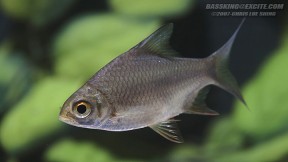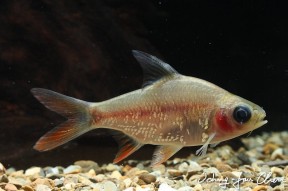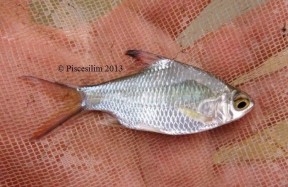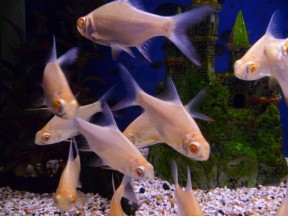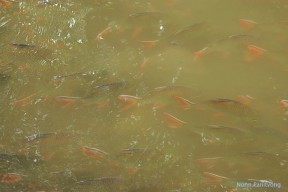Barbonymus schwanefeldii
Tinfoil barb
SynonymsTop ↑
Barbus schwanenfeldii Bleeker, 1854; Systomus schwanefeldi (Bleeker, 1854); Barbus schwanefeldi var. rubra Vaillant, 1902
Etymology
Barbonymus: from the generic name Barbus, to which members of this genus were previously assigned, and Ancient Greek ἀνώνυμος (anṓnumos), meaning ‘anonymous’, since this group of fishes had previously lacked a proper generic name.
schwanefeldii: named for military surgeon H. W. Schwanefeld, who collected the type series.
Classification
Order: Cypriniformes Family: Cyprinidae
Distribution
This species is currently accepted to have an enormous distribution that covers much of Southeast Asia including the countries Cambodia, Laos, Thailand, Vietnam, Singapore, Malaysia (states of Sarawak and Sabah, Borneo), Brunei Darussalam and Indonesia (Sumatra and Kalimantan, Borneo).
It is present in several major river systems including the Mekong and Chao Phraya. In Singapore it was thought to have become locally extinct although it appears that introduced feral populations now exist.
Type locality is ‘Lake Singkara, western Sumatra; Moara kompeh, Palembang, eastern Sumatra; Pangabuang, Lampong, southeastern Sumatra, Indonesia’.
Habitat
Mostly inhabits medium-sized affluent river channels that are prone to flooding during the wet season plus their surrounding floodplains, but increasingly found in man-made canals and lakes. The fish move into inundated riparian areas and forests during these wetter months to feed and spawn, returning to the rivers as the water begins to recede.
Maximum Standard Length
300 – 355 mm.
Aquarium SizeTop ↑
An aquarium with base dimensions of 210 ∗ 60 cm should be the minimum considered.
Maintenance
Choice of décor is not as critical as water quality and the amount of open swimming-space provided; we have seen very healthy-looking specimens being maintained in completely bare set-ups for example.
An enormous external-style filter or two are going to be needed in order to provide the desired levels of oxygen, flow and surface area for bacterial colonisation. Be sure to fit the tank with a heavy, tightly-fitting cover as it can be quite skittish at times and has a powerful leap.
Water Conditions
Temperature: 20 – 28 °C
pH: 6.0 – 8.0
Hardness: 36 – 268 ppm
Diet
Omnivorous and something of an opportunist although studies suggest it is primarily a herbivore; wild Barbonymus have been observed feeding on invertebrates, algae, smaller fish, aquatic and terrestrial plants, and even carcasses of dead animals. In the aquarium it is easily-fed and will accept just about anything offered.
In the aquarium, offer regular meals of live and frozen foods along with good quality dried products and plenty of vegetable matter. Shelled peas, blanched courgette, spinach and chopped fruit all make good additions to the menu. Larger specimens will also take chopped earthworm, prawn, mussel etc., but take care not to overfeed.
Behaviour and CompatibilityTop ↑
Not usually aggressive but will eat small fishes and can upset slow-moving or more timid tank-mates with its constant activity and rather vigorous feeding behaviour. It is therefore only appropriate for very large tanks containing robust, similarly-sized tankmates. There are plenty of suitable choices including many cichlids, catfish, other cyprinids and characins.
This species is found swimming in large schools in nature and some individuals may become skittish or even aggressive if kept in insufficient numbers in the aquarium, meaning a group of six or more should be the smallest considered. You will be rewarded with a much more natural-looking display plus interesting behaviour from the fish as they interact with conspecifics.
Sexual Dimorphism
Mature females are usually deeper-bodied than males especially when gravid. Otherwise there are no obvious external differences.
Reproduction
Not known to have been bred in private aquaria but is used in aquaculture projects in its native countries and further afield. In Hawaii, for example, it is spawned via the use of hormone stimulation. Like others in the genus it is an egg-scatterer species that exhibits no parental care and produces large broods; a single female being capable of releasing thousands of eggs in a single event.
A serious attempt by the hobbyist would not be a tempting prospect as it would require a method of preventing the adults eating the eggs, an enormous aquarium, plus the facilities and contacts to raise and sell on hundreds of fish that are unsuitable for the vast majority of aquaria.
NotesTop ↑
This is one of two species traded under the vernacular name ‘tinfoil barb’, the other being the less well-known congener B. altus. Despite this it appears that B. altus is just as widely available as B. schwanefeldii and in many cases is seen on sale more regularly. Unfortunately both are usually offered at a small size (usually around 50 – 75 mm) with little to no information regarding the eventual size of the fish.
Many shop-owners will tell you that tinfoil barbs are among the species most often returned having outgrown their aquarium, and many can be reluctant to exchange them as the resale value is very low.
The situation has been exacerbated by the development of ornamental colour forms including ‘golden’ and ‘blushing’ strains. These have been selectively-bred for the trade and have slightly gaudier colours than the wild fish thus increasing their sales potential. Care is identical to that described above and all are equally unsuitable for the majority of aquaria. B. schwanefeldii has also been subjected to the practice of artificial dying, an abhorrent and undoubtedly painful process which involves injecting the fish repeatedly with coloured dyes.
The easiest way to differentiate the natural forms of B. altus and B. schwanefeldii is by caudal-fin colour pattern, the latter possessing a distinct black stripe along each lobe which are absent in the former. Additionally adult specimens of B. altus tend to exhibit an overall golden/bronze hue to the body when compared with the more silvery B. schwanefeldii.
Kottelat (1998) described the defining external characteristics of B. schwanefeldii as: dorsal-fin red with a black blotch at the tip; pectoral, pelvic and anal fins red; caudal-fin red with white margin and a black submarginal stripe along each lobe; 8 scale rows between dorsal-fin origin and lateral line“.
B. schwanefeldii may also be spotted with variations in the spelling of the specific epithet such as schwanefeldi or schwanenfeldii because when naming the species Bleeker made a spelling mistake which he later attempted to amend. The name B. schwanenfeldii was most commonly used until Kottelat (2013) emended it on the basis that Bleeker’s error was unintentional and should thus be corrected.
The taxon Barbonymus was erected by Kottelat in 1999 and contains former members of Barbus and Barbodes from Southeast Asia. Most are rare in the ornamental trade, and all have previously been included in the genera Barbus, Puntius, and Barbodes, so you may see them listed with one or more of these names in older literature.
References
- Bleeker, P., 1854 - Natuurkundig Tijdschrift voor Nederlandsch Indië v. 5: 495-534
Nieuwe tientallen diagnostische beschrijvingen van nieuwe of weinig bekende vischsoorten van Sumatra. - Christensen, M. S., 1993 - Asian Fisheries Science 6(1993): 219-222
The Correct Taxonomic Designation for the Southeast Asian Tinfoil Barb: Puntius schwanenfeldii or schwanefeldi? - Freyhof, J., D. V. Serov and T. N. Nguyen, 2000 - Bonner Zoologische Beiträge 49(1-4): 93-99
A preliminary checklist of the freshwater fishes of the River Dong Nai, South Vietnam. - Kottelat, M., 1998 - Icthyological Exploration of Freshwaters 9(1): 1-128
Fishes of the NamTheun and Xe Bangfai basins, Laos, with diagnoses of twenty-two new species (Teleostei: Cyprinidae, Balitoridae, Cobitidae, Coiidae and Odontobutidae). - Kottelat, M., 2013 - The Raffles Bulletin of Zoology Supplement 27: 1-663
The fishes of the inland waters of southeast Asia: a catalogue and core bibiography of the fishes known to occur in freshwaters, mangroves and estuaries. - Kottelat, M., 1999 - The Raffles Bulletin of Zoology 47(2): 591-600
Nomenclature of the genera Barbodes, Cyclocheilichthys, Rasbora and Chonerhinos (Teleostei: Cyprinidae and Tetraodontidae), with comments on the definition of the first reviser. - Kottelat, M. and E. Widjanarti, 2005 - Raffles Bulletin of Zoology Supplement 13: 139-173
The fishes of Danau Sentarum National Park and the Kapuas Lakes area, Kalimantan Barat, Indonesia. - Ng, H. H. and H.-H. Tan, 1999 - Zoological Studies 38(3): 350-366
The fishes of the Endau drainage, Peninsular Malaysia with descriptions of two new species of catfishes (Teleostei: Akysidae, Bagridae). - Parenti, L. R. and K. K. P. Lim, 2005 - The Raffles Bulletin of Zoology Supplement 13: 175-208
Fishes of the Rajang Basin, Sarawak, Malaysia. - Rainboth, W. J., 1996 - FAO, Rome: 1-265
FAO species identification field guide for fishery purposes. Fishes of the Cambodian Mekong. - Roberts, T. R., 1989 - Memoirs of the California Academy of Sciences No. 14: i-xii + 1-210
The freshwater fishes of western Borneo (Kalimantan Barat, Indonesia).


